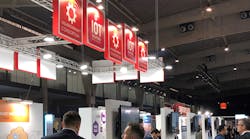The Internet of Things is evolving from concept to reality, and from technology to the way technology is used to solve real operational problems.
The fifth IoT Solutions World Congress opened in Barcelona Oct. 29 with the message that the promises and challenges of IoT have evolved it from idea to an operational tool.
“We’ve been talking about IoT for five years now,” said Dr. Richard Soley, chairman and CEO of the Industrial Internet Consortium (IIC). “Now we’re talking about real applications. This is not a technology show; we’re talking about real success stories.”
Amid the dozens of companies showcasing IoT solutions and the 18,000 expected attendees to the annual event are a series of juried testbeds that demonstrate the real-world applications of IoT data collection, security, and networking.
From improving crop production to developing a more efficient way to monitor and optimize natural gas pumping to improving overall manufacturing production, the testbeds demonstrate a few of the ideas that are being used today to turn data into measurable results.
“It’s important to talk about the use of technology. What’s important is how people are using it,” said Soley. “We’re focusing on the uses of technology, and that’s now driven from the business case.”
“We’re starting to see some real metrics, not just from the testbeds, and the paybacks are great,” added William Hoffman, president of the IIC, which produces the World Congress in partnership with Fira Barcelona.
Companies such as Microsoft, which plays at several stages of the IoT journey, are seeing both the necessary growth in IoT and digital manufacturing, but at a still-slow pace. “We’ve been on the journey to simplify IoT,” said Bert Van Hoof, Microsoft’s group program manager of Azure IoT. “Even with massive adoption, there’s still so much more to be done. It’s a serious tool for a serious business.”
For example, Microsoft’s own Redmond, Wash. campus has more than 2 million sensors that track everything from air movement to people movement. “We saved a ton of energy over time, but it also led us to servicing the buildings in a whole new way. That’s where predictive maintenance comes in.”
The IOT Solutions World Conference offers large companies and smaller software and solutions vendors to be seen and heard on a global stage. What they all have to offer is an access portal to connect data with analytics and a secure and scalable fashion.
“Everything is tailored toward partner enablement,” said Van Hoof. “Everything we do is around the ecosystem. It’s such a big space, and the challenge is getting everyone connected, and then make everything interconnected.”
Manufacturers often cite two barriers to IoT adoption: the perceived cost of implementation and training, and the security of the data. The latter has been addressed by an increasing number of edge computing systems that do the processing work more quickly and ahead of the cloud. The latter, Van Hoof noted, has been part of Microsoft’s efforts to create solutions compatible with the existing sensor network already connected to PLCs and other legacy equipment.
“We’re moving past the PLC to see faster adoption,” Van Hoof said. “IoT is the gateway that opens the conversations about [artificial intelligence] and machine learning.”

